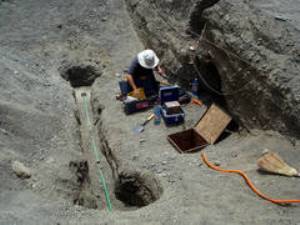Dec 3 2013
On 27 February 2010 an earthquake of magnitude 8.8 struck South-Central Chile near the town of Maule. The main shock displaced the subduction interface by up to 16 meters. Like usually after strong earthquakes a series of aftershocks occurred in the region with decreasing size over the next months.
A surprising result came from an afterslip study: Up to 2 meters additional slip occurred along the plate interface within 420 days only, in a pulse like fashion and without associated seismicity. An international research group lead by GFZ analysed the main shock as well as the following postseismic phase with a dense network of instruments including more than 60 high-resolution GPS stations (Earth and Planetary Science Letters ,Dec. 01, 2013).
 Setting up a Creepmeter Station in Southern Central Chile (Foto: GFZ)
Setting up a Creepmeter Station in Southern Central Chile (Foto: GFZ)
The aftershocks and the now found "silent" afterslip are key to understand the processes occurring after strong earthquakes. The GPS data in combination with seismological data allowed for the first time a comparative analysis: Are after-shocks triggered solely by stress transfer from the main shock or are additional mechanisms active? „Our results suggest, that the classic view of the stress re-laxation due to aftershocks are too simple" says Jonathan Bedford from GFZ to the new observation: „Areas with large stress transfer do not correlate with af-tershocks in all magnitude classes as hitherto assumed and stress shadows show surprisingly high seismic activity."
A conclusion is that local processes which are not detectable at the surface by GPS monitoring along the plate interface have a significant effect on the local stress field. Pressurized fluids in the crust and mantle could be the agent here. As suspected previously, the main and aftershocks might have generated perme-abilities in the source region which are explored by hydrous fluids. This effects the local stress field triggering aftershocks rather independently from the large scale, main shock induced stress transfer. The present study provides evidences for such a mechanism. Volume (3D) seismic tomography which is sensitive to fluid pressure changes in combination with GPS monitoring will allow to better monitor the evolution of such processes.
The main shock was due to a rupture of the interface between the Nasca and the South American plates. Aftershocks are associated with hazards as they can be of similar size as the main shock and, in contrast to the latter, much shallower in the crust.